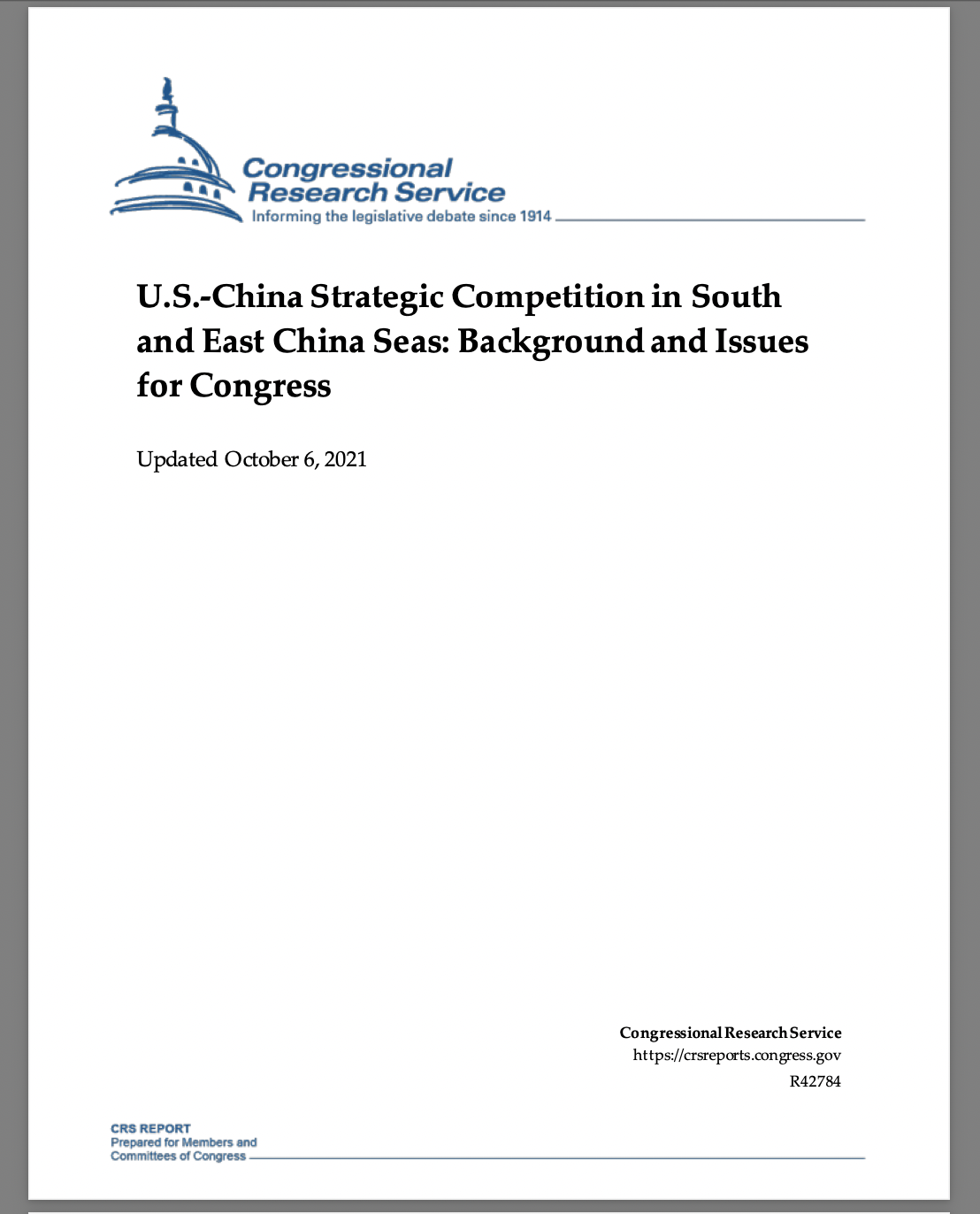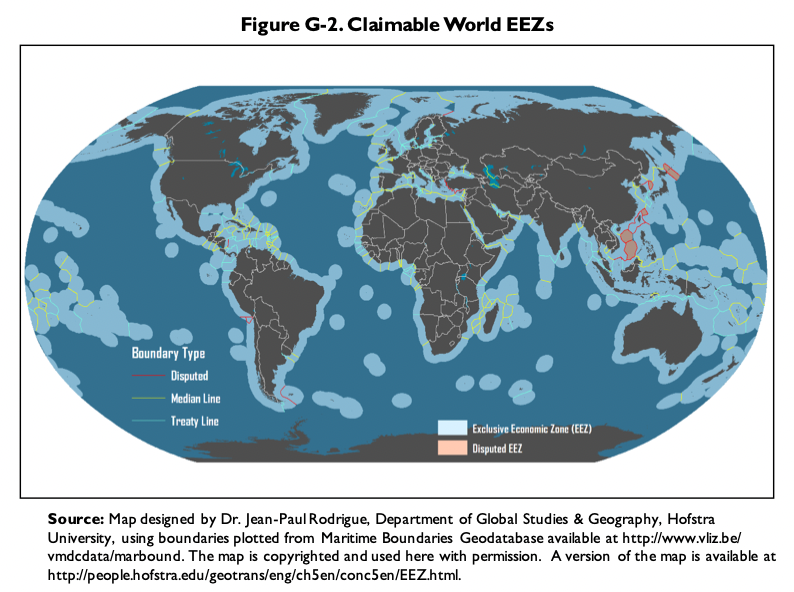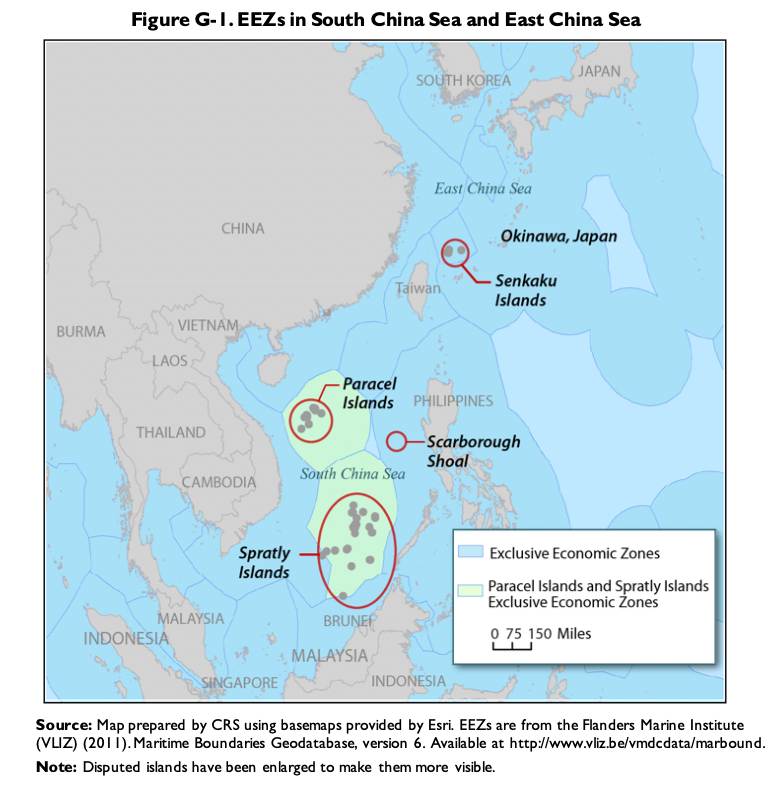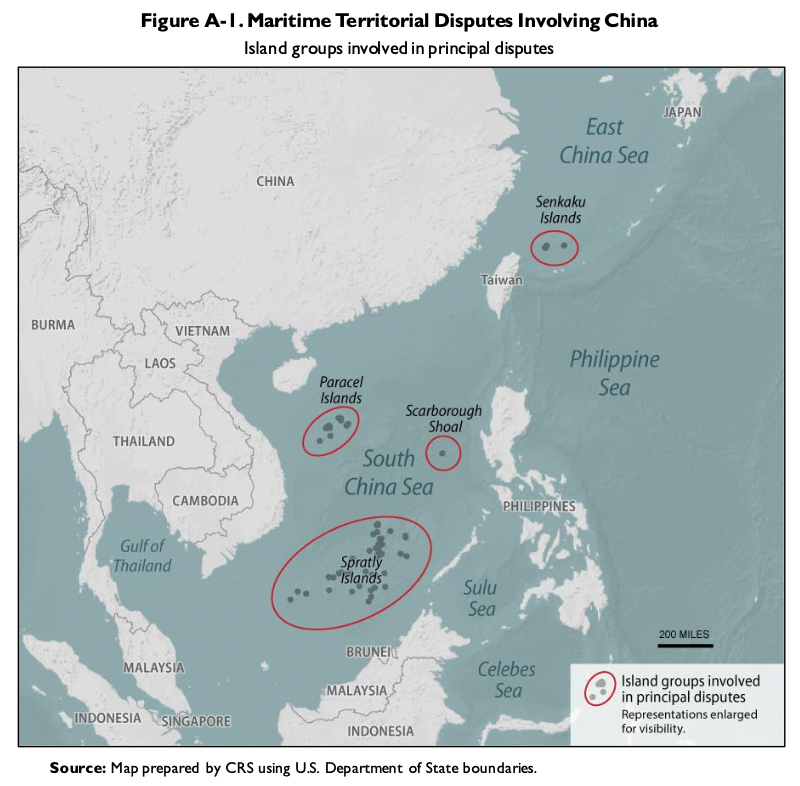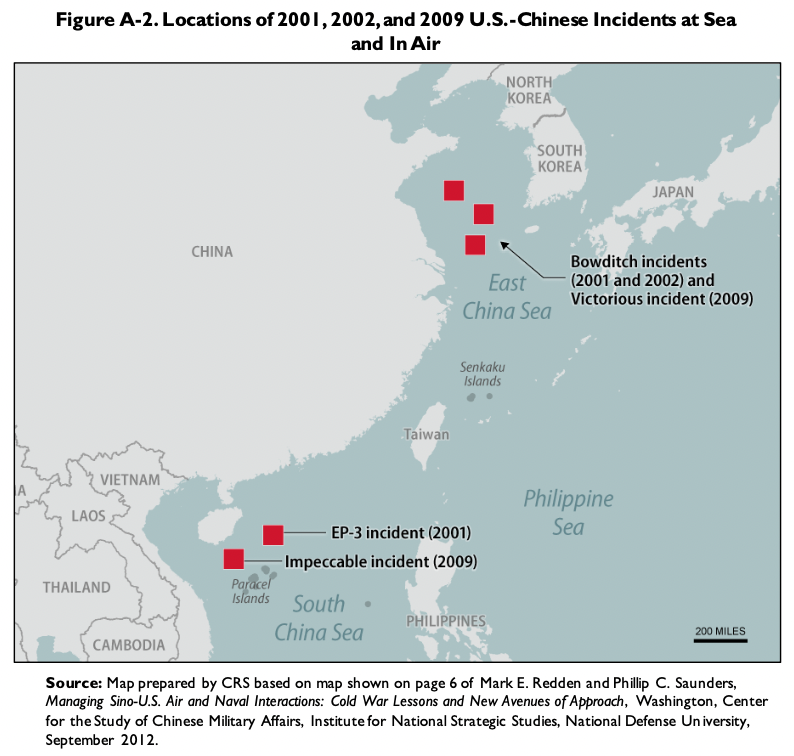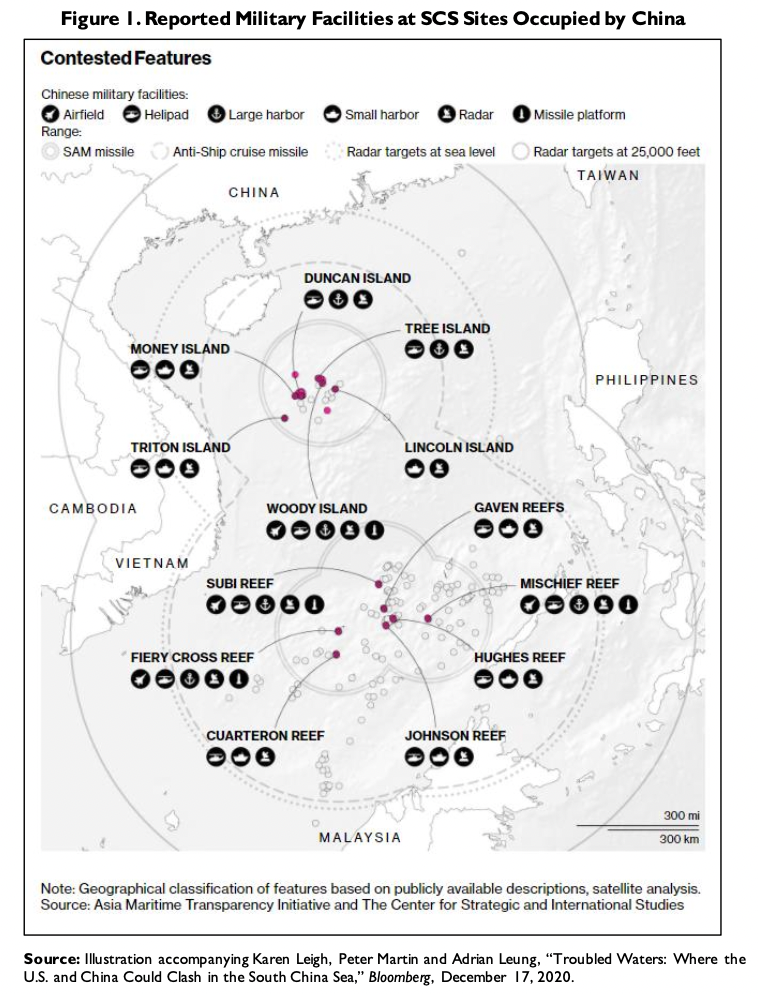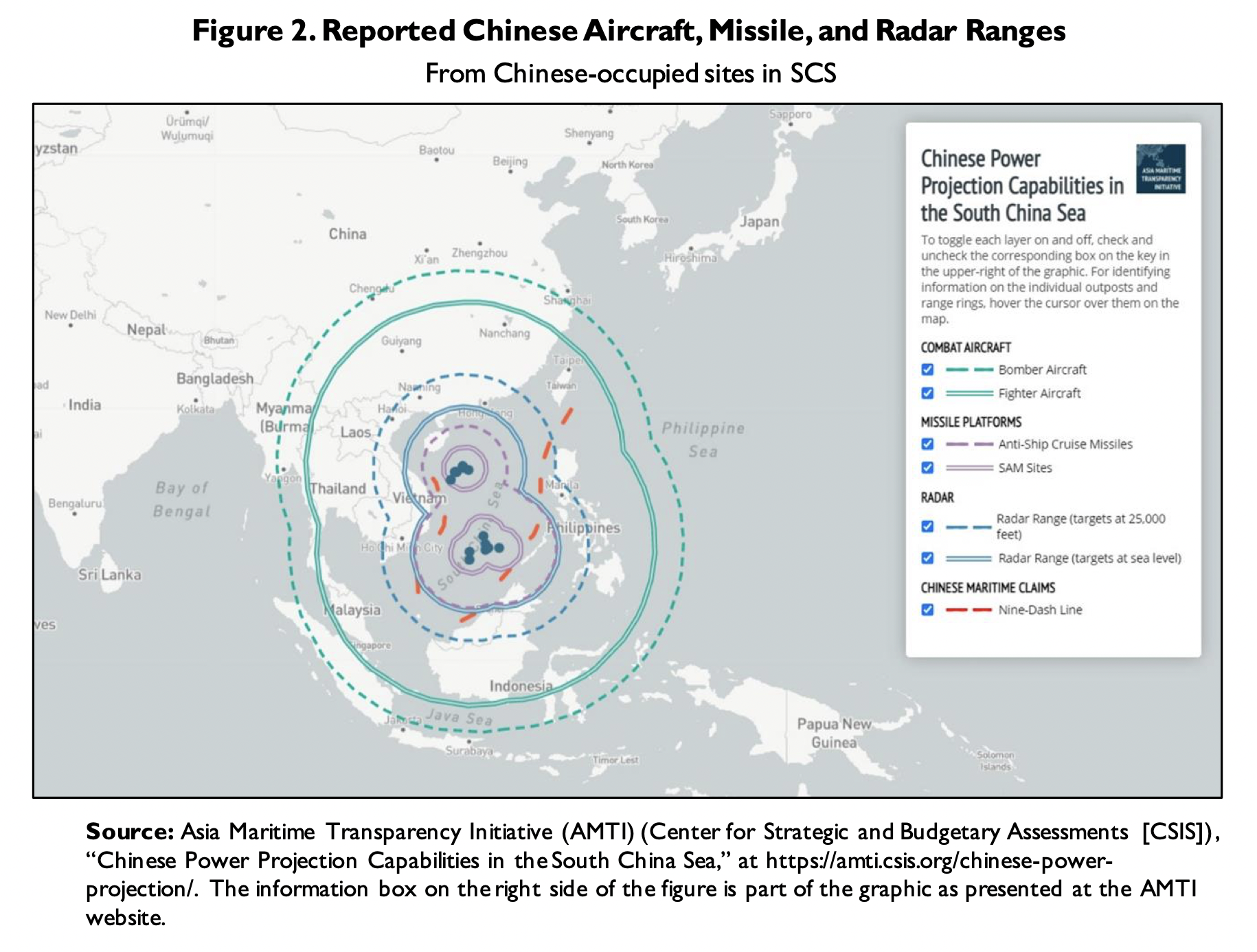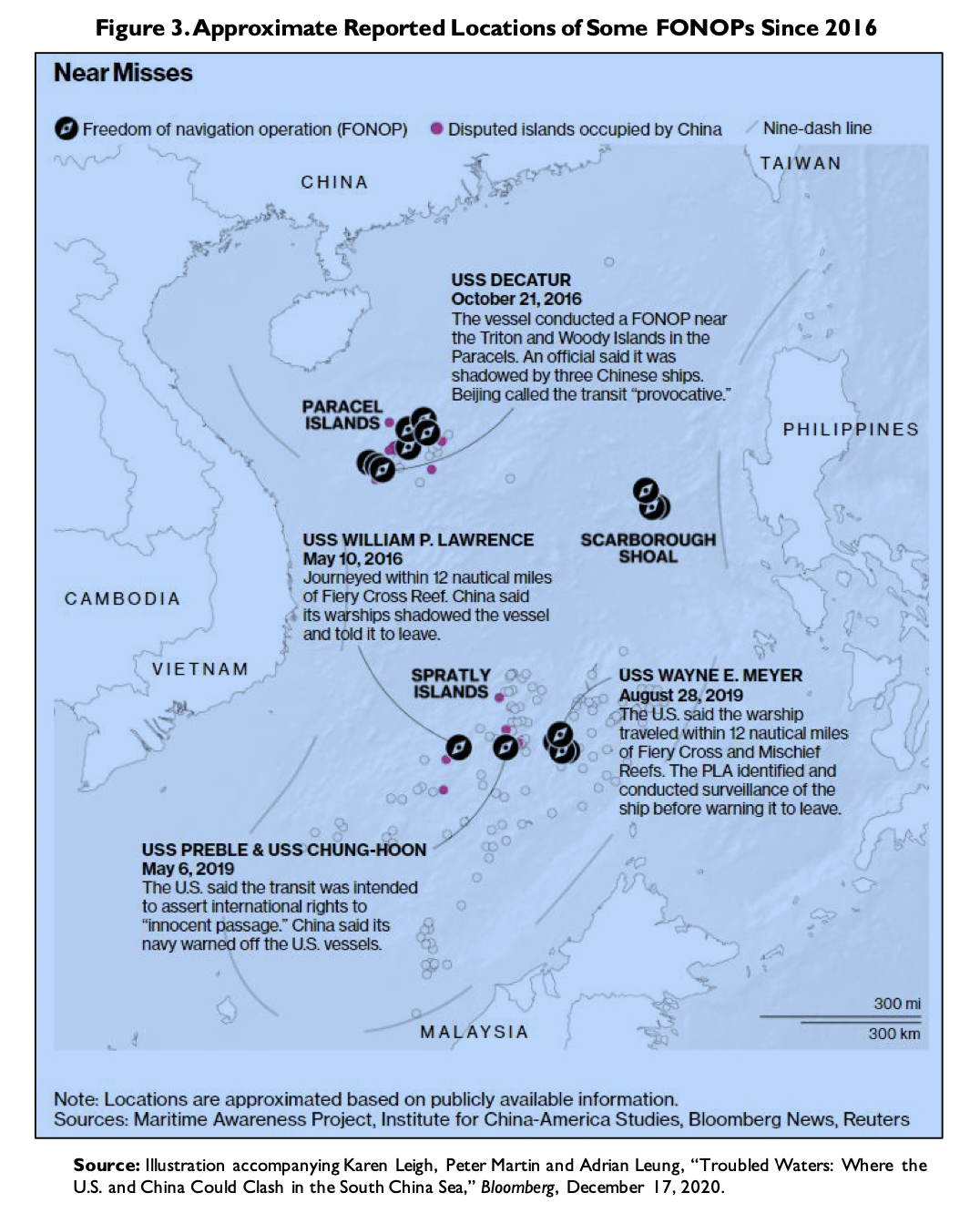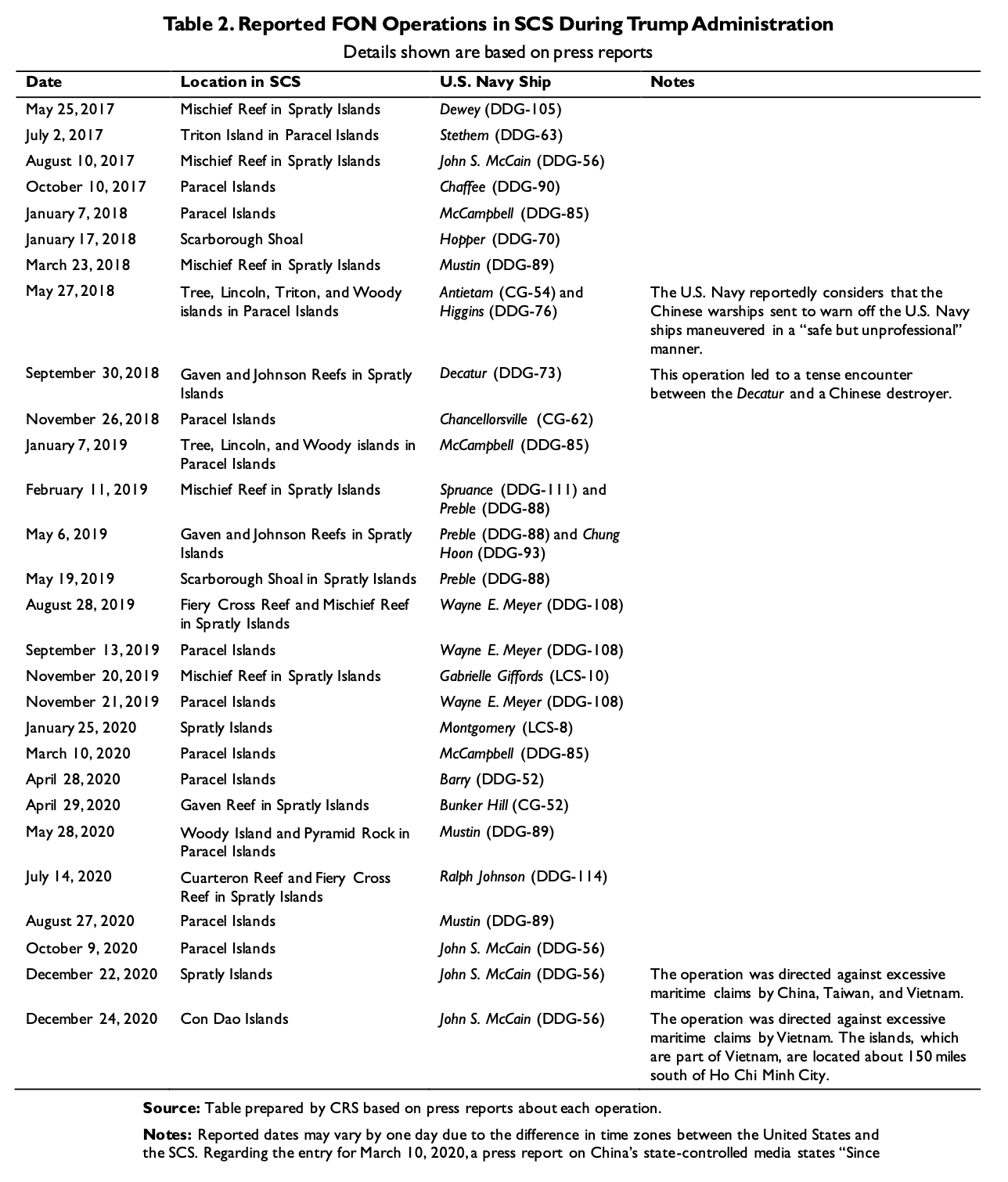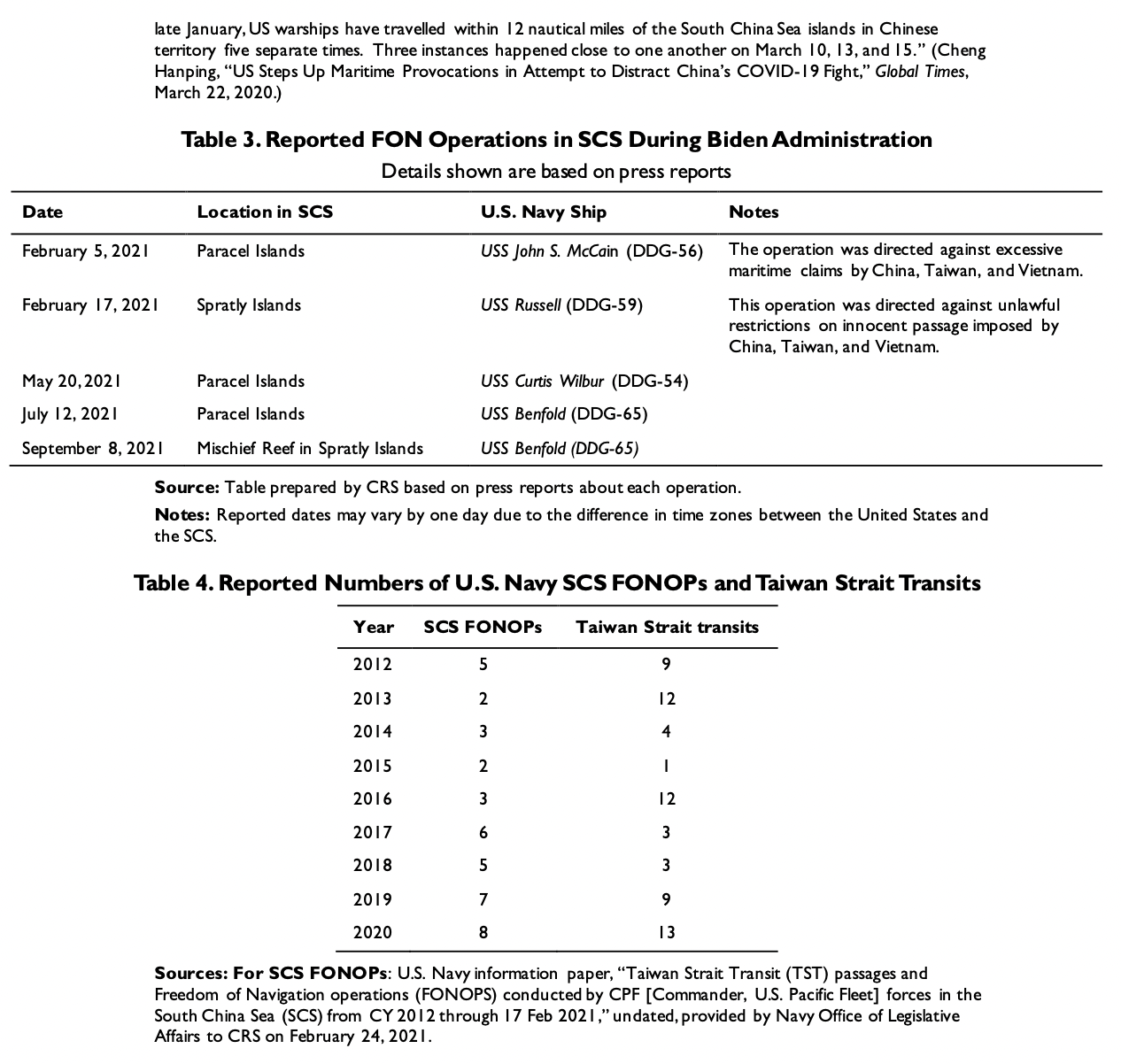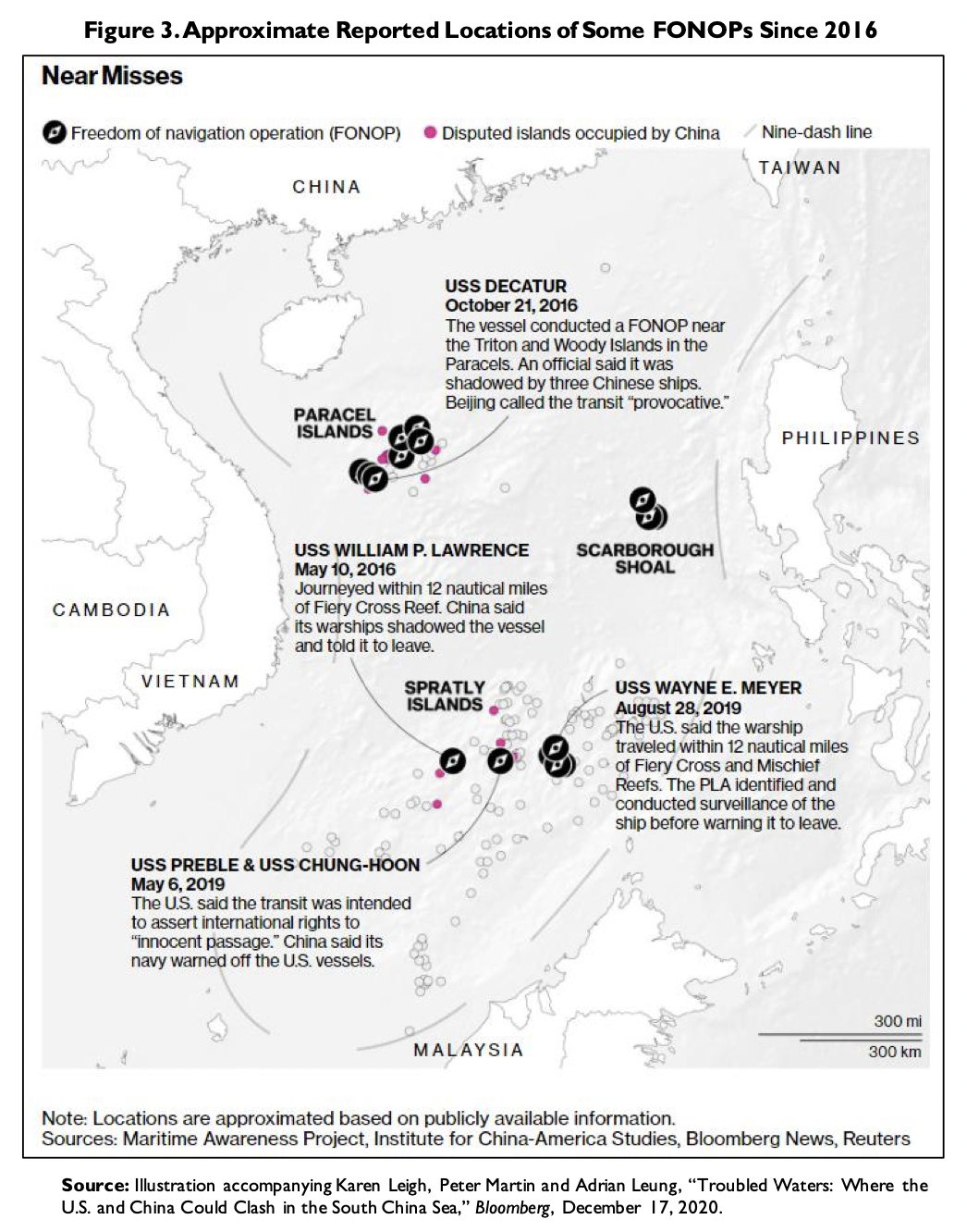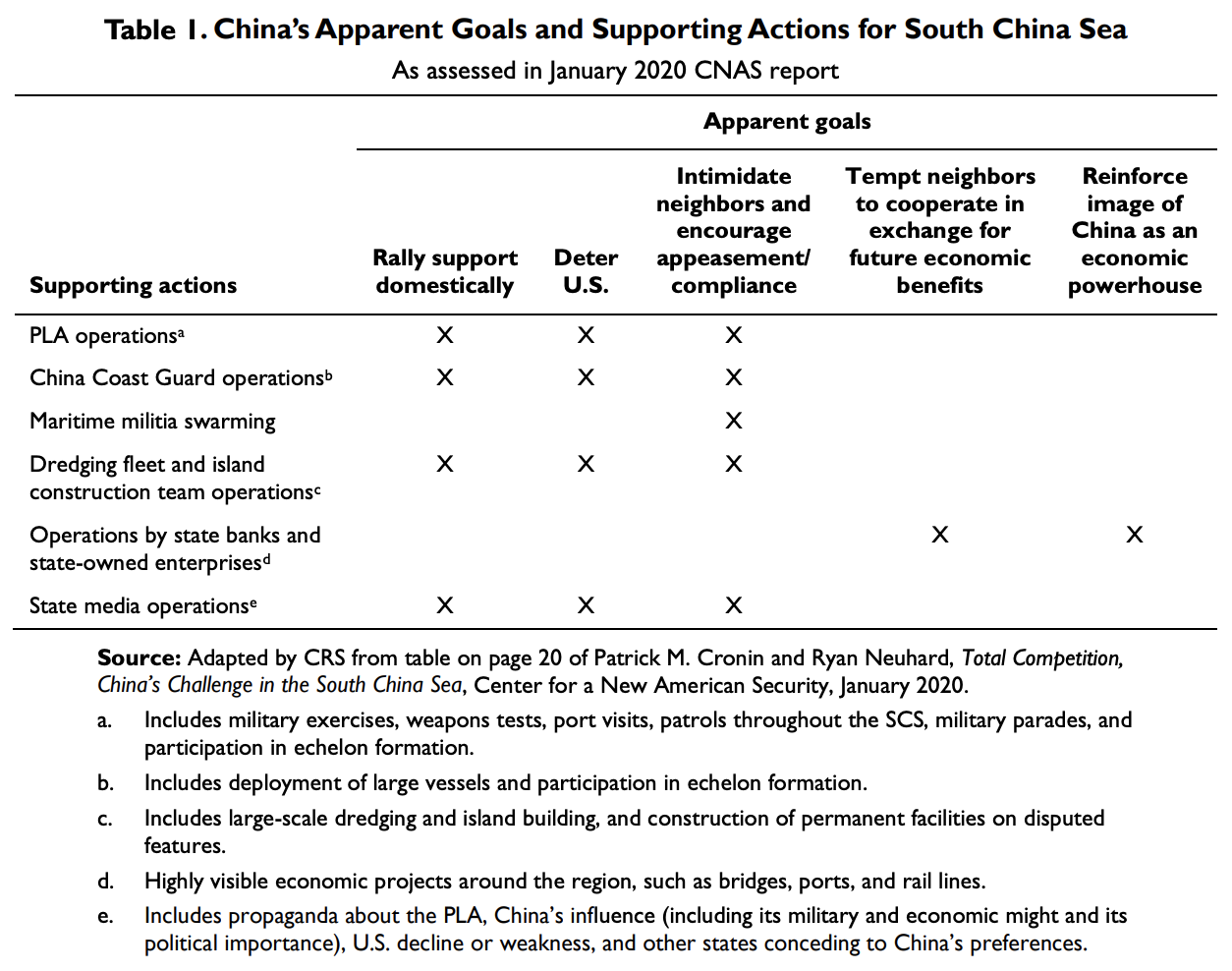O’Rourke’s New CRS Report—“U.S.-China Strategic Competition in South & East China Seas”—Latest on CCG + PAFMM & Gray Zone Ops
If you have trouble accessing the website above, please download a cached copy here.
You can also click here to access the report via the public CRS website.
KEY EXCERPTS:
p. 9
“Salami-Slicing” Strategy and Gray Zone Operations
Observers frequently characterize China’s approach to the SCS and ECS as a “salami-slicing” strategy that employs a series of incremental actions, none of which by itself is a casus belli, to gradually change the status quo in China’s favor. Other observers have referred to China’s approach as a strategy of gray zone operations (i.e., operations that reside in a gray zone between
p. 10
peace and war), of incrementalism,30 creeping annexation31 or creeping invasion,32 or as a “talk and take” strategy, meaning a strategy in which China engages in (or draws out) negotiations while taking actions to gain control of contested areas.33 An April 10, 2021, press report states
China is trying to wear down its neighbors with relentless pressure tactics designed to push its territorial claims, employing military aircraft, militia boats and sand dredgers to dominate access to disputed areas, U.S. government officials and regional experts say.
The confrontations fall short of outright military action without shots being fired, but Beijing’s aggressive moves are gradually altering the status quo, laying the foundation for China to potentially exert control over contested territory across vast stretches of the Pacific Ocean, the officials and experts say….
The Chinese are “trying to grind them down,” said a senior U.S. Defense official….
“Beijing never really presents you with a clear deadline with a reason to use force. You just find yourselves worn down and slowly pushed back,” [Gregory Poling of the Center for Strategic and International Studies] said.34
Some observers argue that China is using the period of the COVID-19 pandemic to further implement its salami-slicing strategy in the SCS while the world’s attention is focused on addressing the pandemic.35
***
30 See, for example, Patrick Mendis and Joey Wang, “China’s Art of Strategic Incrementalism in the South China Sea,” National Interest, August 8, 2020.
31 See, for example, Alan Dupont, “China’s Maritime Power Trip,” The Australian, May 24, 2014.
32 Jackson Diehl, “China’s ‘Creeping Invasion,” Washington Post, September 14, 2014.
33 The strategy has been called “talk and take” or “take and talk.” See, for example, Anders Corr, “China’s Take-And-Talk Strategy In The South China Sea,” Forbes, March 29, 2017. See also Namrata Goswami, “Can China Be Taken Seriously on its ‘Word’ to Negotiate Disputed Territory?” The Diplomat, August 18, 2017.
34 Dan De Luce, “China Tries to Wear Down Its Neighbors with Pressure Tactics,” NBC News, April 10, 2021. See also Dan Altman, “The Future of Conquest, Fights Over Small Places Could Spark the Next Big War,” Foreign Affairs, September 24, 2021.
35 See, for example, Tsukasa Hadano and Alex Fang, “China Steps Up Maritime Activity with Eye on Post-pandemic Order,” Nikkei Asian Review, May 13, 2020; Harsh Pant, “China’s Salami Slicing overdrive: It’s Flexing Military Muscles at a Time When Covid Preoccupies the Rest of the World,” Times of India, May 13, 2020; Veeramalla Anjaiah, “How To Tame Aggressive China In South China Sea Amid COVID-19 Crisis—OpEd,” Eurasia Review, May 14, 2020; Robert A. Manning and Patrick M. Cronin, “Under Cover of Pandemic, China Steps Up Brinkmanship in South China Sea,” Foreign Policy, May 14, 2020; Kathrin Hille and John Reed, “US Looks to Exploit Anger over Beijing’s South China Sea Ambitions,” Financial Times, May 3, 2020. Another observer, offering a somewhat different perspective, states
Recent developments in the South China Sea might lead one to assume that Beijing is taking advantage of the coronavirus crisis to further its ambitions in the disputed waterway. But it’s important to note that China has been following a long-term game plan in the sea for decades. While it’s possible that certain moves were made slightly earlier than planned because of the pandemic, they likely would have been made in any case, sooner or later.
(Steve Mollman, “China’s South China Sea Plan Unfolds Regardless of the Coronavirus,” Quartz, May 9, 2020.)
A May 3, 2020, press report stated
Analysts reject the idea that Beijing has embarked on a new South China Sea campaign during the pandemic. But they do believe the outbreak is having an effect on perceptions of Chinese policy.
“China is doing what it is always doing in the South China Sea, but it is a lot further along the road towards control than it was a few years ago,” said Gregory Poling, director of the Asia Maritime Transparency Initiative at CSIS, the Washington-based think-tank.
(Kathrin Hille and John Reed, “US Looks to Exploit Anger over Beijing’s South China Sea [CONTINUED…]
p. 11
Island Building and Base Construction
Perhaps more than any other set of actions, China’s island-building (aka land-reclamation) and base-construction activities at sites that it occupies in the Paracel Islands and Spratly Islands in the SCS have heightened concerns among U.S. observers that China is rapidly gaining effective control of the SCS. China’s large-scale island-building and base-construction activities in the SCS appear to have begun around December 2013, and were publicly reported starting in May 2014. Awareness of, and concern about, the activities appears to have increased substantially following the posting of a February 2015 article showing a series of “before and after” satellite photographs of islands and reefs being changed by the work.36
China occupies seven sites in the Spratly Islands. It has engaged in island-building and facilities-construction activities at most or all of these sites, and particularly at three of them—Fiery Cross Reef, Subi Reef, and Mischief Reef, all of which now feature lengthy airfields as well as substantial numbers of buildings and other structures. Figure 1 and Figure 2 show reported military facilities at sites that China occupies in the SCS, and reported aircraft, missile, and radar ranges from those sites. Although other countries, such as Vietnam, have engaged in their own island-building and facilities-construction activities at sites that they occupy in the SCS, these efforts are dwarfed in size by China’s island-building and base-construction activities in the SCS.37
New Maritime Law That Went Into Effect on September 1, 2021
A new Chinese maritime law that China approved in April 2021 as an amendment to its 1983 maritime traffic safety law went into effect September 1, 2021. The law seeks to impose new notification and other requirements on foreign ships entering what China describes as “sea areas under the jurisdiction” of China.38 Some observers have stated that the new law could lead to increased tensions in the SCS, particularly if China takes actions to enforce its provisions.39 One observer—a professor of international law and the law of armed conflict at the Naval War College—states:
China recently enacted amendments to its 1983 Maritime Traffic Safety Law, expanding its application from “coastal waters” to “sea areas under the jurisdiction of the People’s Republic of China,” a term that is intentionally vague and not defined. Many of the amendments to the law exceed international law limits on coastal State jurisdiction that would illegally restrict freedom of navigation in the South China, East China, and Yellow Seas where China is embroiled in a number of disputed territorial and maritime claims with
***
Ambitions,” Financial Times, May 3, 2020.)
36 Mira Rapp-Hooper, “Before and After: The South China Sea Transformed,” Asia Maritime Transparency Initiative (AMTI) (Center for Strategic and International Studies [CSIS]), February 18, 2015.
37 See, for example, “Vietnam’s Island Building: Double-Standard or Drop in the Bucket?,” Asia Maritime Transparency Initiative (AMTI) (Center for Strategic and International Studies [CSIS]), May 11, 2016. For additional details on China’s island-building and base-construction activities in the SCS, see, in addition to Appendix E, CRS Report R44072, Chinese Land Reclamation in the South China Sea: Implications and Policy Options, by Ben Dolven et al.
38 See, for example, Amber Wang, “South China Sea: China Demands Foreign Vessels Report before Entering ‘Its Territorial Waters,’” South China Morning Post, August 30, 2021.
39 See, for example, Navmi Krishna, “Explained: Why China’s New Maritime Law May Spike Tensions in South China Sea,” Indian Express, September 7, 2021; Brad Lendon and Steve George, “The Long Arm of China’s New Maritime Law Risks Causing Conflict with US and Japan,” CNN, September 3, 2021; Richard Javad Heydarian, “China’s Foreign Ship Law Stokes South China Sea Tensions,” Asia Times, September 2, 2021. See also James Holmes, “Are China And Russia Trying To Attack The Law Of The Sea?” 19FortyFive, August 31, 2021.
p. 12
its neighbors. The provisions regarding the unilateral application of routing and reporting systems beyond the territorial sea violate UNCLOS. Similarly, application of the mandatory pilotage provisions to certain classes of vessels beyond the territorial sea is inconsistent with UNCLOS and IMO requirements. The amendments additionally impose illegal restrictions on the right of innocent passage in China’s territorial sea and impermissibly restrict the right of the international community to conduct hydrographic and military surveys beyond the territorial sea. China will use the amended law to engage in grey zone operations to intimidate its neighbors and further erode the rule of law at sea in the Indo-Pacific region.40
***
40 Online abstract for Raul (Pete) Pedrozo, “China’s Revised Maritime Traffic Safety Law,” International Law Studies (U.S. Naval War College), Vol. 97, 2021: 956-968. The online abstract is presented at Raul (Pete) Pedrozo, “China’s Revised Maritime Traffic Safety Law,” International Law Studies, U.S. Naval War College, posted June 16, 2021, at https://digital-commons.usnwc.edu/ils/vol97/iss1/39/. See also Nguyen Thanh Trung and Le Ngoc Khanh Ngan, “Codifying Waters and Reshaping Orders: China’s Strategy for Dominating the South China Sea,” Asia Maritime Transparency Initiative (AMTI) (Center for Strategic and International Studies [CSIS]), September 27, 2021.
p. 13
USE OF COAST GUARD SHIPS AND MARITIME MILITIA ………………………………………………………………………………………. 15
China asserts and defends its maritime claims not only with its navy, but also with its coast guard and its maritime militia. Indeed, China employs its maritime militia and its coast guard more regularly and extensively than its navy in its maritime sovereignty-assertion operations. DOD states that China’s navy, coast guard, and maritime militia together “form the largest maritime force in the Indo-Pacific.”45
Apparent Narrow Definition of “Freedom of Navigation”
China regularly states that it supports freedom of navigation and has not interfered with freedom of navigation. China, however, appears to hold a narrow definition of freedom of navigation that is centered on the ability of commercial cargo ships to pass through international waters. In contrast to the broader U.S./Western definition of freedom of navigation (aka freedom of the seas), the Chinese definition does not appear to include operations conducted by military ships and aircraft. It can also be noted that China has frequently interfered with commercial fishing operations by non-Chinese fishing vessels—something that some observers regard as a form of interfering with freedom of navigation for commercial ships.
Position Regarding Regulation of Military Forces in EEZs
As mentioned earlier, the position of China and some other countries (i.e., a minority group among the world’s nations) is that UNCLOS gives coastal states the right to regulate not only economic activities, but also foreign military activities, in their EEZs.
Depiction of United States as Outsider Seeking to “Stir Up Trouble”
Along with its preference for treating territorial disputes on a bilateral rather than multilateral basis (see Appendix E for details), China resists and objects to U.S. involvement in maritime disputes in the SCS and ECS. Statements in China’s state-controlled media sometimes depict the United States as an outsider or interloper whose actions (including freedom of navigation operations) are meddling or seeking to “stir up trouble” in an otherwise peaceful regional situation. Potential or actual Japanese involvement in the SCS is sometimes depicted in China’s state-controlled media in similar terms. Depicting the United States in this manner can be viewed as consistent with goals of attempting to drive a wedge between the United States and its allies and partners in the region and of ensuring maximum leverage in bilateral (rather than multilateral) discussions with other countries in the region over maritime territorial disputes.
***
45 Department of Defense, Annual Report to Congress [on] Military and Security Developments Involving the People’s Republic of China 2018, p. 16. See also Andrew S. Erickson, “Maritime Numbers Game, Understanding and Responding to China’s Three Sea Forces,” Indo-Pacific Defense Forum, January 28, 2019.
p. 20
U.S. Statements in April and June 202053
An April 9, 2020, DOD statement stated
The Department of Defense is greatly concerned by reports of a China Coast Guard vessel’s collision with and sinking of a Vietnam fishing vessel in the vicinity of the Paracel Islands in the South China Sea.
The PRC’s behavior stands in contrast to the United States’ vision of a free and open Indo-Pacific region, in which all nations, large and small, are secure in their sovereignty, free from coercion, and able to pursue economic growth consistent with accepted international rules and norms. The United States will continue to support efforts by our allies and partners to ensure freedom of navigation and economic opportunity throughout the entire Indo-Pacific.
The COVID-19 pandemic underscores the importance of the rules based international order, as it sets the conditions that enable us to address this shared threat in a way that is transparent, focused, and effective. We call on all parties to refrain from actions that would destabilize the region, distract from the global response to the pandemic, or risk needlessly contributing to loss of life and property.54
In an April 22, 2020, statement, then-Secretary of State Mike Pompeo stated
***
53 For examples of statements of the U.S. position other than those shown here, see Michael Pillsbury, ed., A Guide to the Trump Administration’s China Policy Statements, Hudson Institute, August 2020, 253 pp. Examples can be found in this publication by searching on terms such as “South China Sea,” East China Sea,” “freedom of navigation,” and “freedom of the seas.”
54 Department of Defense, “China Coast Guard Sinking of a Vietnam Fishing Vessel,” April 9, 2020.
p. 21
Even as we fight the [COVID-19] outbreak, we must remember that the long-term threats to our shared security have not disappeared. In fact, they’ve become more prominent. Beijing has moved to take advantage of the distraction, from China’s new unilateral announcement of administrative districts over disputed islands and maritime areas in the South China Sea, its sinking of a Vietnamese fishing vessel earlier this month, and its “research stations” on Fiery Cross Reef and Subi Reef. The PRC continues to deploy maritime militia around the Spratly Islands and most recently, the PRC has dispatched a flotilla that included an energy survey vessel for the sole purpose of intimidating other claimants from engaging in offshore hydrocarbon development. It is important to highlight how the Chinese Communist Party (CCP) is exploiting the world’s focus on the COVID-19 crisis by continuing its provocative behavior. The CCP is exerting military pressure and coercing its neighbors in the SCS, even going so far as to sink a Vietnamese fishing vessel. The U.S. strongly opposes China’s bullying and we hope other nations will hold them to account too.55
***
55 Department of State, “The United States and ASEAN are Partnering to Defeat COVID-19, Build Long-Term Resilience, and Support Economic Recovery,” Press Statement, Michael R. Pompeo, Secretary of State, April 22, 2020. See also A. Ananthalakshmi and Rozanna Latiff, “U.S. Says China Should Stop ‘Bullying Behaviour’ in South China Sea,” Reuters, April 18, 2020; Gordon Lubold and Dion Nissenbaum, “With Trump Facing Virus Crisis, U.S. Warns Rivals Not to Seek Advantage,” Wall Street Journal, April 20, 2020; Brad Lendon, “Coronavirus may be giving Beijing an opening in the South China Sea,” CNN, April 7, 2020; Agence France-Presse, “US Warns China Not to ‘Exploit’ Virus for Sea Disputes,” Channel News Asia, April 6, 2020.
p. 31
Specific Actions
Specific actions taken by the Trump Administration included the following, among others:
- As an apparent cost-imposing measure, DOD announced on May 23, 2018, that it was disinviting China from the 2018 RIMPAC (Rim of the Pacific) exercise.82
***
82 RIMPAC is a U.S.-led, multilateral naval exercise in the Pacific involving naval forces from more than two dozen countries that is held every two years. At DOD’s invitation, China participated in the 2014 and 2016 RIMPAC exercises. DOD had invited China to participate in the 2018 RIMPAC exercise, and China had accepted that invitation. DOD’s statement regarding the withdrawal of the invitation was reprinted in Megan Eckstein, “China Disinvited from Participating in 2018 RIMPAC Exercise,” USNI News, May 23, 2018. See also Gordon Lubold and Jeremy Page, “U.S. Retracts Invitation to China to Participate in Military Exercise,” Wall Street Journal, May 23, 2018. See also Helene Cooper, “U.S. Disinvites China From Military Exercise Amid Rising Tensions,” New York Times, May 23, 2018; Missy Ryan, “Pentagon Disinvites China from Major Naval Exercise over South China Sea Buildup,” Washington Post, May 23, 2018; James Stavridis, “U.S. Was Right to Give China’s navy the Boot,” Bloomberg, August 2, 2018.
p. 32
In November 2018, national security adviser John Bolton said the U.S. would oppose any agreements between China and other claimants to the South China Sea that limit free passage to international shipping.83
- In January 2019, the then-U.S. Chief of Naval Operations, Admiral John Richardson, reportedly warned his Chinese counterpart that the U.S. Navy would treat China’s coast guard cutters and maritime militia vessels as combatants and respond to provocations by them in the same way as it would respond to provocations by Chinese navy ships.84
- On March 1, 2019, Secretary of State Michael Pompeo stated, “As the South China Sea is part of the Pacific, any armed attack on Philippine forces, aircraft, or public vessels in the South China Sea will trigger mutual defense obligations under Article 4 of our Mutual Defense Treaty [with the Philippines].”85 (For more on this treaty, see Appendix B.)
- As discussed earlier, on July 13, 2020, Secretary Pompeo issued a statement that strengthened, elaborated, and made more specific certain elements of the U.S. position regarding China’s actions in the SCS.
- On August 26, 2020, Secretary Pompeo announced that the United States had begun “imposing visa restrictions on People’s Republic of China (PRC) individuals responsible for, or complicit in, either the large-scale reclamation, construction, or militarization of disputed outposts in the South China Sea, or the
***
83 Jake Maxwell Watts, “Bolton Warns China Against Limiting Free Passage in South China Sea,” Wall Street Journal, November 13, 2018.
84 See Demetri Sevastopulo and Kathrin Hille, “US Warns China on Aggressive Acts by Fishing Boats and Coast Guard; Navy Chief Says Washington Will Use Military Rules of Engagement to Curb Provocative Behavior,” Financial Times, April 28, 2019. See also Shirley Tay, “US Reportedly Warns China Over Hostile Non-Naval Vessels in South China Sea,” CNBC, April 29, 2019; Ryan Pickrell, “China’s South China Sea Strategy Takes a Hit as the US Navy Threatens to Get Tough on Beijing’s Sea Forces,” Business Insider, April 29, 2019; Tyler Durden, “‘Warning Shot Across The Bow:’ US Warns China On Aggressive Acts By Maritime Militia,” Zero Hedge, April 29, 2019; Ankit Panda, “The US Navy’s Shifting View of China’s Coast Guard and ‘Maritime Militia,’” Diplomat, April 30, 2019; Ryan Pickrell, “It Looks Like the US Has Been Quietly Lowering the Threshold for Conflict in the South China Sea,” Business Insider, June 19, 2019.
85 State Department, Remarks With Philippine Foreign Secretary Teodoro Locsin Jr., Remarks [by] Michael R. Pompeo, Secretary of State, March 1, 2019, accessed August 21, 2019 at https://www.state.gov/remarks-with-philippine-foreign-secretary-teodoro-locsin-jr/. See also James Kraska, “China’s Maritime Militia Vessels May Be Military Objectives During Armed Conflict,” Diplomat, July 7, 2020.
See also Regine Cabato and Shibani Mahtani, “Pompeo Promises Intervention If Philippines Is Attacked in South China Sea Amid Rising Chinese Militarization,” Washington Post, February 28, 2019; Claire Jiao and Nick Wadhams, “We Have Your Back in South China Sea, U.S. Assures Philippines,” Bloomberg, February 28 (updated March 1), 2019; Jake Maxwell Watts and Michael R. Gordon, “Pompeo Pledges to Defend Philippine Forces in South China Sea, Philippines Shelves Planned Review of Military Alliance After U.S. Assurances,” Wall Street Journal, March 1, 2019; Jim Gomez, “Pompeo: US to Make Sure China Can’t Blockade South China Sea,” Associated Press, March 1, 2019; Karen Lema and Neil Jerome Morales, “Pompeo Assures Philippines of U.S. Protection in Event of Sea Conflict, Reuters, March 1, 2019; Raissa Robles, “US Promises to Defend the Philippines from ‘Armed Attack’ in South China Sea, as Manila Mulls Review of Defence Treaty,” South China Morning Post, March 1, 2019; Raul Dancel, “US Will Defend Philippines in South China Sea: Pompeo,” Straits Times, March 2, 2019; Ankit Panda, “In Philippines, Pompeo Offers Major Alliance Assurance on South China Sea,” Diplomat, March 4, 2019; Mark Nevitt, “The US-Philippines Defense Treaty and the Pompeo Doctrine on South China Sea,” Just Security, March 11, 2019; Zack Cooper, “The U.S. Quietly Made a Big Splash about the South China Sea; Mike Pompeo Just Reaffirmed Washington Has Manila’s back,” Washington Post, March 19, 2019; Jim Gomez, “US Provides Missiles, Renews Pledge to Defend Philippines,” Associated Press, November 23, 2020; Karen Lema, “‘We’ve Got Your Back’—Trump Advisor Vows U.S. Support in South China Sea,” Reuters, November 23, 2020.
p. 33
PRC’s use of coercion against Southeast Asian claimants to inhibit their access to offshore resources.”86
- On January 14, 2021, Secretary Pompeo announced additional sanctions against Chinese officials, including executives of state-owned enterprises and officials of the Chinese Communist Party and China’s navy “responsible for, or complicit in, either the large-scale reclamation, construction, or militarization of disputed outposts in the South China Sea, or the PRC’s use of coercion against Southeast Asian claimants to inhibit their access to offshore resources in the South China Sea.”87
- Also on January 14, 2021, the Commerce Department added China’s state-owned Chinese National Offshore Oil Corporation (CNOOC) to the Entity List, restricting exports to that firm, citing CNOOC’s role in “helping China intimidate neighbors in the South China Sea.”88
Biden Administration’s Strategy
Statements in 2021
A January 27, 2021, press report stated that
[President] Biden reaffirmed in a telephone call with the Japanese prime minister the U.S.’s commitment to defend uninhabited islands controlled by Japan and claimed by China that have been a persistent point of contention between the Asian powerhouses. Meanwhile, newly confirmed U.S. Secretary of State Antony Blinken rejected Chinese territorial claims in a call with his Philippine counterpart and emphasized U.S. alliances in talks with top Australian and Thai officials.89
***
86 Department of State, “U.S. Imposes Restrictions on Certain PRC State-Owned Enterprises and Executives for Malign Activities in the South China Sea,” press statement, Michael R. Pompeo, Secretary of State, August 26, 2020. See also Susan Heavey, Daphne Psaledakis, and David Brunnstrom, “U.S. Targets Chinese Individuals, Companies amid South China Sea Dispute,” Reuters, August 26, 2020; Matthew Lee (Associated Press), “US Imposes Sanctions on Chinese Defense Firms over Maritime Dispute,” Defense News, August 26, 2020; Kate O’Keeffe and Chun Han Wong, “U.S. Sanctions Chinese Firms and Executives Active in Contested South China Sea,” Wall Street Journal, August 26, 2020; Ana Swanson, “U.S. Penalizes 24 Chinese Companies Over Role in South China Sea,” New York Times, August 26, 2020; Tal Axelrod, “US Restricting Travel of Individuals Over Beijing’s Moves in South China Sea,” The Hill, August 26, 2020; Jeanne Whalen, “U.S. Slaps Trade Sanctions on More Chinese Entities, This Time for South China Sea Island Building,” Washington Post, August 26, 2020; Gavin Bade, “U.S. Blacklists 24 Chinese Firms, Escalating Military and Trade Tensions,” Politico, August 26, 2020; Paul Handley, “US Blacklists Chinese Individuals, Firms For South China Sea Work,” Barron’s, August 26, 2020. See also Gregory Poling and Zack Cooper, “Washington Tries Pulling Economic Levers in the South China Sea,” Asia Maritime Transparency Initiative (AMTI) (Center for Strategic and International Studies [CSIS]), August 28, 2020; Hau Dinh and Yves Dam Van, “US to ASEAN: Reconsider Deals with Blacklisted China Firms,” Associated Press, September 10, 2020; Michael McDevitt, “Washington Takes a Stand in the South China Sea,” CNA (Arlington, VA), September 8, 2020.
87 Department of State, “Protecting and Preserving a Free and Open South China Sea,” January 14, 2021. See also Matthew Lee, “US Imposes New Sanction on Beijing over South China Sea,” Associated Press, January 14, 2021.
88 Department of Commerce, “Commerce Adds China National Offshore Oil Corporation to the Entity List and Skyrizon to the Military End-User List,” January 14, 2021. See also Ben Lefebvre, “U.S. Bans Exports to China’s State-Owned Oil Company CNOOC,” Politico Pro, January 14, 2021.
89 Isabel Reynolds, “Biden Team Slams China Claims in Swift Calls to Asia Allies,” Bloomberg, January 27 (updated January 28), 2021.
p. 34
A January 28, 2021, press report similarly stated
One week into the job, US President Joe Biden has sent a clear warning to Beijing against any expansionist intentions in East and Southeast Asia.
In multiple calls and statements, he and his top security officials have underscored support for allies Japan, South Korea, Taiwan and the Philippines, signaling Washington’s rejection of China’s disputed territorial claims in those areas.
On Wednesday [January 27], Biden told Japanese Prime Minister Yoshihide Suga that his administration is committed to defending Japan, including the Senkaku Islands, which are claimed both by Japan and China, which calls them the Diaoyu Islands.
That stance was echoed by Defense Secretary Lloyd Austin, who told Japanese counterpart Nobuo Kishi on Saturday that the contested islands were covered by the US-Japan Security Treaty.
Austin affirmed that the United States “remains opposed to any unilateral attempts to change the status quo in the East China Sea,” according to a Pentagon statement on the call. expansionist intentions in East and Southeast Asia.90
Regarding the above-mentioned call between Secretary of State Antony Blinken and Philippine Secretary of Foreign Affairs Locsin, a January 27, 2021, State Department statement stated that in the call, Blinken
reaffirmed that a strong U.S.-Philippine Alliance is vital to a free and open Indo-Pacific region. Secretary Blinken stressed the importance of the Mutual Defense Treaty for the security of both nations, and its clear application to armed attacks against the Philippine armed forces, public vessels, or aircraft in the Pacific, which includes the South China Sea. Secretary Blinken also underscored that the United States rejects China’s maritime claims in the South China Sea to the extent they exceed the maritime zones that China is permitted to claim under international law as reflected in the 1982 Law of the Sea Convention. Secretary Blinken pledged to stand with Southeast Asian claimants in the face of PRC pressure.91
A January 22, 2021, press report stated
Washington’s defense treaty with Tokyo applies to the Japan-administered Senkaku Islands, the new U.S. national security adviser confirmed Thursday [January 21], in an early show of support for an ally regarding a source of regional tension.
In a 30-minute phone call that marked the first official contact between high-level officials from the two countries since U.S. President Joe Biden took office Wednesday, Jake Sullivan and Japanese counterpart Shigeru Kitamura reaffirmed the importance of the alliance.
Sullivan said the U.S. opposes any unilateral actions intended to harm Japan’s administration of the Senkakus — which are claimed by China as the Diaoyu — and is
***
90 Sylvie Lanteaume (Agence France-Presse), “In Multiple Messages, Biden Warns Beijing over Expansionism,” Yahoo News, January 28, 2021. See also Wendy Wu and Teddy Ng, “China-US Tension: Biden Administration Pledges to Back Japan and Philippines in Maritime Disputes,” South China Morning Post, January 28, 2021.
91 Department of State, “Secretary Blinken’s Call with Philippine Secretary of Foreign Affairs Locsin,” January 27, 2021. See also Mohammad Zargham and Karen Lema, “U.S. Stands with SE Asian Countries Against China Pressure, Blinken Says,” Reuters, January 27 (updated January 28), 2021; Sebastian Strangio, “Biden Administration Reaches out to Southeast Asian Allies,” Diplomat, January 28, 2021; Ken Moriyasu, “US Vows to Defend Philippines, Including in South China Sea,” Nikkei Asia, January 29, 2021; Frances Mangosing, “New Pentagon Chief Commits Support for PH in South China Sea,” Philippine Daily Inquirer, February 10, 2021.
p. 35
committed to its obligations under the treaty, according to the Japanese government’s readout. The call was requested by Tokyo.92
As noted earlier, on February 19, 2021, the State Department stated that
we reaffirm the [earlier-cited] statement of July 13th, 2020 [by then-Secretary of State Pompeo] regarding China’s unlawful and excessive maritime claims in the South China Sea. Our position on the PRC’s maritime claims remains aligned with the 2016 Arbitral Tribunal’s finding that China has no lawful claim in areas it found to be in the Philippines exclusive economic zone or continental shelf.
We also reject any PRC claim to waters beyond the 12 nautical mile territorial sea from islands it claims in the Spratlys. China’s harassment in these areas of other claimants, state hydrocarbon exploration or fishing activity, or unilateral exploitation of those maritime resources is unlawful.93
A February 24, 2021, press report stated
The Pentagon has urged Beijing to stop sending government vessels into Japanese waters, following more incursions by China’s coast guard vessels near the Senkaku Islands over the weekend.
Beijing’s continued deployment of ships near the islets controlled by Japan “could lead to miscalculation”—or physical and material harm, Department of Defense spokesperson John Kirby said Tuesday [February 23]….
Nations should be “free from coercion and able to pursue economic growth consistent with accepted rules and norms,” Pentagon press secretary John Kirby told reporters during Tuesday’s off-camera briefing.
He said the Chinese government, through its actions, was undermining the rules-based international order, one in which Beijing itself has benefited.
“We would urge the Chinese to avoid actions, using their Coast Guard vessels, that could lead to miscalculation and potential physical, if not—and material harm,” Kirby said, according to a DoD read-out.94
On March 16, 2021, following a U.S.-Japan “2+2” ministerial meeting that day in Tokyo between Secretary of State Blinken, Secretary of Defense Lloyd Austin, Japanese Foreign Minister Toshimitsu Motegi, and Japanese Defense Minister Nobuo Kishi, the U.S.-Japan Security Consultative Committee released a U.S.-Japan joint statement for the press that stated in part:
Amid growing geopolitical competition and challenges such as COVID-19, climate change, and revitalizing democracy, the United States and Japan renewed their commitment to promoting a free and open Indo-Pacific and a rules-based international order.
The United States and Japan acknowledged that China’s behavior, where inconsistent with the existing international order, presents political, economic, military, and technological challenges to the Alliance and to the international community. The Ministers committed to opposing coercion and destabilizing behavior toward others in the region, which
***
92 Masaya Kato and Shohei Kanaya, “Team Biden Assures Japan that Senkakus Fall Under Security Treaty,” Nikkei Asia, January 22, 2021.
93 U.S. Department of State, “Department Press Briefing—February 19, 2021,” Ned Price, Department Spokesperson, Washington, DC, February 19, 2021.
94 John Feng, “Pentagon Warns China About ‘Miscalculation’ Over Actions in Japanese Waters,” Newsweek, February 24, 2021. See also Kyodo News, “U.S. Raps China on Activities Near Senkakus, Says It Supports Japan,” Kyodo News, February 24, 2021; Kyodo News, “Pentagon Says Remarks on Senkaku Islands Sovereignty Were ‘Error,’” Kyodo News, February 27, 2021.
p. 36
undermines the rules-based international system. They reaffirmed their support for unimpeded lawful commerce and respect for international law, including freedom of navigation and overflight and other lawful uses of the sea. The Ministers also expressed serious concerns about recent disruptive developments in the region, such as the China Coast Guard law. Further, they discussed the United States’ unwavering commitment to the defense of Japan under Article V of our security treaty, which includes the Senkaku Islands. The United States and Japan remain opposed to any unilateral action that seeks to change the status quo or to undermine Japan’s administration of these islands. The Ministers underscored the importance of peace and stability in the Taiwan Strait. They reiterated their objections to China’s unlawful maritime claims and activities in the South China Sea and recalled that the July 2016 award of the Philippines-China arbitral tribunal, constituted under the 1982 Law of the Sea Convention, is final and legally binding on the parties.95
See also the previously quoted July 11, 2021, statement from Secretary of State Antony Blinken issued in connection with the fifth anniversary of the July 12, 2016, arbitral tribunal ruling on the South China Sea.
March 2021 Report of U.S.-Taiwan Coast Guard Agreement
A March 25, 2021, press report stated that
Taiwan and the United States have signed their first agreement under the Biden administration, establishing a Coast Guard Working Group to coordinate policy, following China’s passing of a law that allows its coast guard to fire on foreign vessels….
The defacto Taiwanese ambassador to the United States, Hsiao Bi-khim, signed the agreement in Washington on Thursday [March 25], her office said in a statement.
“It is our hope that with the new Coast Guard Working Group, both sides will forge a stronger partnership and jointly contribute even more to a free and open Indo-Pacific region.”
U.S. Acting Assistant Secretary of State for East Asian and Pacific Affairs Sung Kim was at the signing ceremony, the office said.96 …
***
95 Department of State, “U.S.-Japan Joint Press Statement,” Media Note, Office of the Spokesperson, March 16, 2021. See also Lara Jakes, Motoko Rich and John Ismay, “Visiting Japan, Top U.S. Envoys Set Combative Tone for China Talks,” New York Times, March 16, 2021.
96 Ben Blanchard, “Taiwan, U.S. to Strengthen Maritime Coordination After China Law,” Reuters, March 25, 2021.
p. 60
1972 Convention on Preventing Collisions at Sea (COLREGs)
China and the United States, as well as more than 150 other countries (including all those bordering on the South East and South China Seas, but not Taiwan),152 are parties to an October 1972 multilateral convention on international regulations for preventing collisions at sea, commonly known as the collision regulations (COLREGs) or the “rules of the road.”153 Although
[CONTINUED… ]
***
152 Source: International Maritime Organization, Status of Multilateral Conventions and Instruments in Respect of Which the International Maritime Organization or its Secretary-General Performs Depositary or Other Functions, As at 28 February 2014, pp. 86-89. The Philippines acceded to the convention on June 10, 2013.
153 28 UST 3459; TIAS 8587. The treaty was done at London October 20, 1972, and entered into force July 15, 1977. The United States is an original signatory to the convention and acceded the convention entered into force for the United States on July 15, 1977. China acceded to the treaty on January 7, 1980. A summary of the agreement is
[CONTINUED… ]
p. 61
commonly referred to as a set of rules or regulations, this multilateral convention is a binding treaty. The convention applies “to all vessels upon the high seas and in all waters connected therewith navigable by seagoing vessels.”154 It thus applies to military vessels, paramilitary and law enforcement (i.e., coast guard) vessels, maritime militia vessels, and fishing boats, among other vessels.
In a February 18, 2014, letter to Senator Marco Rubio concerning the December 5, 2013, incident involving the Cowpens, the State Department stated the following:
In order to minimize the potential for an accident or incident at sea, it is important that the United States and China share a common understanding of the rules for operational air or maritime interactions. From the U.S. perspective, an existing body of international rules and guidelines—including the 1972 International Regulations for Preventing Collisions at Sea (COLREGs)—are sufficient to ensure the safety of navigation between U.S. forces and the force of other countries, including China. We will continue to make clear to the Chinese that these existing rules, including the COLREGs, should form the basis for our common understanding of air and maritime behavior, and we will encourage China to incorporate these rules into its incident-management tools.
Likewise, we will continue to urge China to agree to adopt bilateral crisis management tools with Japan and to rapidly conclude negotiations with ASEAN155 on a robust and meaningful Code of Conduct in the South China in order to avoid incidents and to manage them when they arise. We will continue to stress the importance of these issues in our regular interactions with Chinese officials.156
In the 2014 edition of its annual report on military and security developments involving China, the DOD states the following:
On December 5, 2013, a PLA Navy vessel and a U.S. Navy vessel operating in the South China Sea came into close proximity. At the time of the incident, USS COWPENS (CG 63) was operating approximately 32 nautical miles southeast of Hainan Island. In that location, the U.S. Navy vessel was conducting lawful military activities beyond the territorial sea of any coastal State, consistent with customary international law as reflected in the Law of the Sea Convention. Two PLA Navy vessels approached USS COWPENS. During this interaction, one of the PLA Navy vessels altered course and crossed directly in front of the bow of USS COWPENS. This maneuver by the PLA Navy vessel forced USS COWPENS to come to full stop to avoid collision, while the PLA Navy vessel passed less than 100 yards ahead. The PLA Navy vessel’s action was inconsistent with internationally recognized rules concerning professional maritime behavior (i.e., the Convention of International Regulations for Preventing Collisions at Sea), to which China is a party.157
***
available at http://www.imo.org/About/Conventions/ListOfConventions/Pages/COLREG.aspx. The text of the convention is available at https://treaties.un.org/doc/Publication/UNTS/Volume%201050/volume-1050-I-15824-English.pdf.
154 Rule 1(a) of the convention.
155 ASEAN is the Association of Southeast Asian Nations. ASEAN’s member states are Brunei, Cambodia, Indonesia, Laos, Malaysia, Myanmar, the Philippines, Singapore, Thailand, and Vietnam.
156 Letter dated February 18, 2014, from Julia Frifield, Assistant Secretary, Legislative Affairs, Department of State, to The Honorable Marco Rubio, United States Senate. Used here with the permission of the office of Senator Rubio. The letter begins: “Thank you for your letter of January 31 regarding the December 5, 2013, incident involving a Chinese naval vessel and the USS Cowpens.” The text of Senator Rubio’s January 31, 2014, letter was accessed March 13, 2014, at http://www.rubio.senate.gov/public/index.cfm/2014/1/rubio-calls-on-administration-to-address-provocative-chinese-behavior.
157 Department of Defense, Annual Report to Congress [on] Military and Security Developments Involving the People’s Republic of China 2014, p. 4.
p. 86
Use of Coast Guard Ships and Maritime Militia
Coast Guard Ships
Overview
DOD states that the China Coast Guard (CCG) is the world’s largest coast guard.200 It is much larger than the coast guard of any other country in the region,201 and it has increased substantially in size in recent years through the addition of many newly built ships. China makes regular use of CCG ships to assert and defend its maritime claims, particularly in the ECS, with Chinese navy ships sometimes available over the horizon as backup forces.202 The Defense Intelligence Agency (DIA) states the following:
Under Chinese law, maritime sovereignty is a domestic law enforcement issue under the purview of the CCG. Beijing also prefers to use CCG ships for assertive actions in disputed waters to reduce the risk of escalation and to portray itself more benignly to an international audience. For situations that Beijing perceives carry a heightened risk of escalation, it often deploys PLAN combatants in close proximity for rapid intervention if necessary. China also relies on the PAFMM—a paramilitary force of fishing boats—for sovereignty enforcement actions….
China primarily uses civilian maritime law enforcement agencies in maritime disputes, employing the PLAN [i.e., China’s navy] in a protective capacity in case of escalation.
***
200 Department of Defense, Annual Report to Congress [on] Military and Security Developments Involving the People’s Republic of China 2018, p. 71.
201 For a comparison of the CCG to other coast guards in the region in terms of cumulative fleet tonnage in 2010 and 2016, see the graphic entitled “Total Coast Guard Tonnage of Selected Countries” in China Power Team, “Are Maritime Law Enforcement Forces Destabilizing Asia?” China Power (Center for Strategic and International Studies [CSIS]), updated August 26, 2020, accessed February 18, 2021, at https://chinapower.csis.org/maritime-forces-destabilizing-asia/.
202 See Department of Defense, Annual Report to Congress [on] Military and Security Developments Involving the People’s Republic of China 2015, pp. 3, 7, and 44, and Department of Defense, Asia-Pacific Maritime Security Strategy, undated but released August 2015, p. 14. An April 8, 2021, press report states
Chinese stealthy catamaran fast-attack missile craft [belonging to China’s navy] have reportedly been involved in an incident with a boat chartered by a Philippine media company in the hotly contested waters of the South China Sea. According to an account citing ABS-CBN reporter Chiara Zambrano, the Type 022 Houbei class vessels appeared today in the Second Thomas Shoal, a submerged reef located in the disputed Spratly Islands. The missile craft then apparently aggressively chased away the boat operated on behalf of the ABS-CBN news crew, which had been sailing in the area to monitor the movements of other Chinese vessels.
(Thomas Newdick, “Now China Has Cruise Missile Carrying Catamarans Chasing Away Ships In The South China Sea, The Appearance of the Chinese Catamaran Fast-Attack Missile Craft Adds a Significant New Player to These Disputed Waters,” The Drive, April 8, 2021.)
p. 87
The CCG has rapidly increased and modernized its forces, improving China’s ability to enforce its maritime claims. Since 2010, the CCG’s large patrol ship fleet (more than 1,000 tons) has more than doubled in size from about 60 to more than 130 ships, making it by far the largest coast guard force in the world and increasing its capacity to conduct extended offshore operations in a number of disputed areas simultaneously. Furthermore, the newer ships are substantially larger and more capable than the older ships, and the majority are equipped with helicopter facilities, high-capacity water cannons, and guns ranging from 30-mm to 76-mm. Among these ships, a number are capable of long-distance, long-endurance out-of-area operations. In addition, the CCG operates more than 70 fast patrol combatants ([each displacing] more than 500 tons), which can be used for limited offshore operations, and more than 400 coastal patrol craft (as well as about 1,000 inshore and riverine patrol boats). By the end of the decade, the CCG is expected to add up to 30 patrol ships and patrol combatants before the construction program levels off.203
In March 2018, China announced that control of the CCG would be transferred from the civilian State Oceanic Administration to the Central Military Commission.204 The transfer occurred on July 1, 2018.205 On May 22, 2018, it was reported that China’s navy and the CCG had conducted their first joint patrols in disputed waters off the Paracel Islands in the SCS, and had expelled at least 10 foreign fishing vessels from those waters.206
Law Passed by China on January 22, 2021
A January 22, 2021, press report stated
China passed a law on Friday [January 22] that for the first time explicitly allows its coast guard to fire on foreign vessels, a move that could make the contested waters around China more choppy.…
China’s top legislative body, the National People’s Congress standing committee, passed the Coast Guard Law on Friday, according to state media reports.
According to draft wording in the bill published earlier, the coast guard is allowed to use “all necessary means” to stop or prevent threats from foreign vessels.
The bill specifies the circumstances under which different kind of weapons – hand-held, ship borne or airborne – can be used.
***
203 Defense Intelligence Agency, China Military Power, Modernizing a Force to Fight and Win, 2019, pp. 66, 78. A similar passage appears in Department of Defense, Annual Report to Congress [on] Military and Security Developments Involving the People’s Republic of China 2018, pp. 71-72.
204 See, for example, David Tweed, “China’s Military Handed Control of the Country’s Coast Guard,” Bloomberg, March 26, 2018.
205 See, for example, Global Times, “China’s Military to Lead Coast Guard to Better Defend Sovereignty,” People’s Daily Online, June 25, 2018. See also Economist, “A New Law Would Unshackle China’s Coastguard, Far from Its Coast,” Economist, December 5, 2020; Katsuya Yamamoto, “The China Coast Guard as a Part of the China Communist Party’s Armed Forces,” Sasakawa Peace Foundation, December 10, 2020.
206 Catherine Wong, “China’s Navy and Coastguard Stage First Joint Patrols Near Disputed South China Sea Islands as ‘Warning to Vietnam,’” South China Morning Post, May 22, 2018. For additional discussion of China’s coast guard, see Andrew S. Erickson, Joshua Hickey, and Henry Holst, “Surging Second Sea Force: China’s Maritime Law-Enforcement Forces, Capabilities, and Future in the Gray Zone and Beyond,” Naval War College Review, Spring 2019; Teddy Ng and Laura Zhou, “China Coast Guard Heads to Front Line to Enforce Beijing’s South China Sea Claims,” South China Morning Post, February 9, 2019; Ying Yu Lin, “Changes in China’s Coast Guard,” Diplomat, January 30, 2019. See also Ryan D. Martinson, “Early Warning Brief: Introducing the ‘New, New’ China Coast Guard,” China Brief, January 25, 2021.
p. 88
The bill allows coast guard personnel to demolish other countries’ structures built on Chinese-claimed reefs and to board and inspect foreign vessels in waters claimed by China.
The bill also empowers the coastguard to create temporary exclusion zones “as needed” to stop other vessels and personnel from entering.
Responding to concerns, Chinese foreign ministry spokeswoman Hua Chunying said on Friday that the law is in line with international practices.207
On February 19, 2021, the State Department stated that
the United States joins the Philippines, Vietnam, Indonesia, Japan, and other countries in expressing concern with China’s recently enacted Coast Guard law, which may escalate ongoing territorial and maritime disputes.
We are specifically concerned by language in the law that expressly ties the potential use of force, including armed force by the China Coast Guard, to the enforcement of China’s claims in ongoing territorial and maritime disputes in the East and South China Seas.
Language in that law, including text allowing the coast guard to destroy other countries’ economic structures and to use force in defending China’s maritime claims in disputed areas, strongly implies this law could be used to intimidate the PRC’s maritime neighbors.
We remind the PRC and all whose force operates – whose forces operate in the South China Sea that responsible maritime forces act with professionalism and restraint in the exercise of their authorities.
We are further concerned that China may invoke this new law to assert its unlawful maritime claims in the South China Sea, which were thoroughly repudiated by the 2016 Arbitral Tribal[1] ruling. In this regard, the United States reaffirms its statement of July 13th, 2020 regarding maritime claims in the South China Sea.
The United States reminds China of its obligations under the United Nations Charter to refrain from the threat or use of force, and to conform its maritime claims to the
***
207 Yew Lun Tian, “China Authorises Coast Guard to Fire on Foreign Vessels if Needed,” Reuters, January 22, 2021. See also Wataru Okada, “China’s Coast Guard Law Challenges Rule-Based Order,” Diplomat, May 28, 2021; Nguyen Thanh Trung, “How China’s Coast Guard Law Has Changed the Regional Security Structure,” Asia Maritime Transparency Initiative (AMTI) (Center for Strategic and International Studies [CSIS]), April 12, 2021; Kawashima Shin, “China’s Worrying New Coast Guard Law, Japan Is Watching the Senkaku Islands Closely,” Diplomat, March 17, 2021;Editorial Board, “China’s New Coast Guard Law Appears Designed to Intimidate,” Japan Times, March 4, 2021; Ryan D. Martinson, “The Real Risks of China’s New Coastguard Law, The Use-of-Force Provisions Are Just the Beginning,” National Interest, March 3, 2021; Sumathy Permal, “Beijing Bolsters the Role of the China Coast Guard,” Asia Maritime Transparency Initiative (AMTI) (Center for Strategic and International Studies [CSIS]), March 1, 2021; Katsuya Yamamoto, “Concerns about the China Coast Guard Law—the CCG and the People’s Armed Police,” Sasakawa Peace Foundation, February 25, 2021; Asahi Shimbun, “New Chinese Law Raises Pressure on Japan around Senkaku Islands,” Asahi Shimbun, February 24, 2021; Ryan D. Martinson, “Gauging the Real Risks of China’s New Coastguard Law,” Strategist, February 23, 2021; Eli Huang, “New Law Expands Chinese Coastguard’s Jurisdiction to at Least the First Island Chain,” Strategist, February 16, 2021; Shigeki Sakamoto, “China’s New Coast Guard Law and Implications for Maritime Security in the East and South China Seas,” Lawfare, February 16, 2021; Expert Voices, “Voices: The Chinese Maritime Police Law,” Maritime Awareness Project, February 11, 2021 (includes portions with subsequent dates); Seth Robson, “China Gets More Aggressive with Its Sea Territory Claims as World Battles Coronavirus,” Stars and Stripes, February 1, 2021; Shuxian Luo, “China’s Coast Guard Law: Destabilizing or Reassuring?” Diplomat, January 29, 2021; Shigeki Sakamoto, “China’s New Coast Guard Law and Implications for Maritime Security in the East and South China Seas,” Lawfare, February 16, 2021; Michael Shoebridge, “Xi Licenses Chinese Coastguard to be ‘Wolf Warriors’ at Sea,” Strategist, February 15, 2021; “New Law Institutionalises Chinese Maritime Coercion,” Oxford Analytica Daily Brief, February 15, 2021.
p. 89
International Law of the Sea, as reflected in the 1982 Law of the Sea Convention. We stand firm in our respective alliance commitments to Japan and the Philippines.208
On March 16, 2021, following a U.S.-Japan “2+2” ministerial meeting that day in Tokyo between Secretary of State Blinken, Secretary of Defense Lloyd Austin, Japanese Foreign Minister Toshimitsu Motegi, and Japanese Defense Minister Nobuo Kishi, the U.S.-Japan Security Consultative Committee released a U.S.-Japan joint statement for the press that stated in part that the minister “expressed serious concerns about recent disruptive developments in the region, such as the China Coast Guard law.209
Maritime Militia
China also uses the People’s Armed Forces Maritime Militia (PAFMM)—a force that essentially consists of fishing ships with armed crew members—to defend its maritime claims. In the view of some observers, the PAFMM—even more than China’s navy or coast guard—is the leading component of China’s maritime forces for asserting its maritime claims, particularly in the SCS. U.S. analysts in recent years have paid increasing attention to the role of the PAFMM as a key tool for implementing China’s salami-slicing strategy, and have urged U.S. policymakers to focus on the capabilities and actions of the PAFMM.210
***
208 U.S. Department of State, “Department Press Briefing—February 19, 2021,” Ned Price, Department Spokesperson, Washington, DC, February 19, 2021. During the question-and-answer portion of the briefing, the following exchange occurred:
QUESTION: I have two quick questions about the Chinese coast guard law. Have you raised concern directly with Beijing? And secondly, has the U.S. seen any examples of concerning behavior since the law was passed in either the South China Sea or the East China Sea?
MR PRICE: For that, I think, Demetri, we would want to—we might want to refer you to DOD for instances of concerning behavior—for concerning behavior there. When it comes to the coast guard law, of course, we have been in close contact with our allies and partners, and we mentioned a few of them in this context: the Philippines, Vietnam, Indonesia, Japan, and other countries that face the type of unacceptable PRC pressure in the South China Sea. I wouldn’t want to characterize any conversations with Beijing on this. Of course, we have emphasized that, especially at the outset of this administration, our—the first and foremost on our agenda is that coordination among our partners and allies, and we have certainly been engaged deeply in that.
See also Demetri Sevastopulo, Kathrin Hille, and Robin Harding, “US Concerned at Chinese Law Allowing Coast Guard Use of Arms,” Financial Times, February 19, 2021; Simon Lewis, Humeyra Pamuk, Daphne Psaledakis, and David Brunnstrom, “U.S. Concerned China’s New Coast Guard Law Could Escalate Maritime Disputes,” Reuters, February 19, 2021.
209 Department of State, “U.S.-Japan Joint Press Statement,” Media Note, Office of the Spokesperson, March 16, 2021. See also Ralph Jennings, “Maritime Law Expected to Give Beijing an Edge in South China Sea Legal Disputes,” Voice of America (VOA), March 15, 2021; Junko Horiuchi, “Japan, U.S. Express ‘Serious Concerns’ over China Coast Guard Law,” Kyodo News, March 16, 2021.
210 For additional discussions of the PAFMM, see, for example, Zachary Haver, “Unmasking China’s Maritime Militia,” BenarNews, May 17, 2021; Ryan D. Martinson, “Xi Likes Big Boats (Coming Soon to a Reef Near You),” War on the Rocks, April 28, 2021; Andrew S. Erickson and Ryan D. Martinson, “Records Expose China’s Maritime Militia at Whitsun Reef, Beijing Claims They Are Fishing Vessels. The Data Shows Otherwise,” Foreign Policy, March 29, 2021; Zachary Haver, “China’s Civilian Fishing Fleets Are Still Weapons of Territorial Control,” Center for Advanced China Research, March 26, 2021; Chung Li-hua and Jake Chung, “Chinese Coast Guard an Auxiliary Navy: Researcher,” Taipei Times, June 29, 2020; Gregory Poling, “China’s Hidden Navy,” Foreign Policy, June 25, 2019; Mike Yeo, “Testing the Waters: China’s Maritime Militia Challenges Foreign Forces at Sea,” Defense News, May 31, 2019; Laura Zhou, “Beijing’s Blurred Lines between Military and Non-Military Shipping in South China Sea Could Raise Risk of Flashpoint,” South China Morning Post, May 5, 2019; Andrew S. Erickson, “Fact Sheet: The People’s Armed Forces Maritime Militia (PAFMM),” April 29, 2019, Andrewerickson.com; Jonathan Manthorpe, “Beijing’s Maritime Militia, the Scourge of South China Sea,” Asia Times, April 27, 2019; Ryan D. Martinson, “Manila’s Images Are Revealing the Secrets of China’s Maritime Militia, Details of the Ships Haunting Disputed Rocks Sshow China’s
p. 90
DOD states that “the PAFMM is the only government-sanctioned maritime militia in the world,” and that it “has organizational ties to, and is sometimes directed by, China’s armed forces.”211 DIA states that
The PAFMM is a subset of China’s national militia, an armed reserve force of civilians available for mobilization to perform basic support duties. Militia units organize around towns, villages, urban subdistricts, and enterprises, and they vary widely from one location to another. The composition and mission of each unit reflects local conditions and personnel skills. In the South China Sea, the PAFMM plays a major role in coercive activities to achieve China’s political goals without fighting, part of broader Chinese military doctrine that states that confrontational operations short of war can be an effective means of accomplishing political objectives.
A large number of PAFMM vessels train with and support the PLA and CCG in tasks such as safeguarding maritime claims, protecting fisheries, and providing logistic support, search and rescue (SAR), and surveillance and reconnaissance. The Chinese government subsidizes local and provincial commercial organizations to operate militia ships to perform “official” missions on an ad hoc basis outside their regular commercial roles. The PAFMM has played a noteworthy role in a number of military campaigns and coercive incidents over the years, including the harassment of Vietnamese survey ships in 2011, a standoff with the Philippines at Scarborough Reef in 2012, and a standoff involving a Chinese oil rig in 2014. In the past, the PAFMM rented fishing boats from companies or individual fisherman, but it appears that China is building a state-owned fishing fleet for its maritime militia force in the South China Sea. Hainan Province, adjacent to the South China Sea, ordered the construction of 84 large militia fishing boats with reinforced hulls and ammunition storage for Sansha City, and the militia took delivery by the end of 2016.212
***
Plans,” Foreign Policy, April 19, 2021; Brad Lendon, “Beijing Has a Navy It Doesn’t Even Admit Exists, Experts Say. And It’s Swarming Parts of the South China Sea,” CNN, April 13, 2021; Samir Puri and Greg Austin, “What the Whitsun Reef Incident Tells Us About China’s Future Operations at Sea,” International Institute for Strategic Studies (IISS), April 9, 2021; Drake Long, “Chinese Maritime Militia on the Move in Disputed Spratly Islands,” Radio Free Asia, March 24, 2021; Andrew S. Erickson, “China’s Secretive Maritime Militia May Be Gathering at Whitsun Reef, Boats Designed to Overwhelm Civilian Foes Can Be Turned into Shields in Real Conflict,” Foreign Policy, March 22, 2021; Dmitry Filipoff, “Andrew S. Erickson and Ryan D. Martinson Discuss China’s Maritime Gray Zone Operations,” Center for International Maritime Security (CIMSEC), March 11, 2019; Jamie Seidel, “China’s Latest Island Grab: Fishing ‘Militia’ Makes Move on Sandbars around Philippines’ Thitu Island,” News.com.au, March 5, 2019; Gregory Poling, “Illuminating the South China Sea’s Dark Fishing Fleets,” Stephenson Ocean Security Project (Center for Strategic and International Studies), January 9, 2019; Andrew S. Erickson, “Shining a Spotlight: Revealing China’s Maritime Militia to Deter its Use,” National Interest, November 25, 2018; Todd Crowell and Andrew Salmon, “Chinese Fisherman Wage Hybrid ‘People’s War’ on Asian Seas,” Asia Times, September 6, 2018; Andrew S. Erickson, “Exposed: Pentagon Report Spotlights China’s Maritime Militia,” National Interest, August 20, 2018; Jonathan Odom, “China’s Maritime Militia,” Straits Times, June 16, 2018; Conor M. Kennedy and Andrew S. Erickson, China’s Third Sea Force, The People’s Armed Forces Maritime Militia: Tethered to the PLA, China Maritime Report No. 1, China Maritime Studies Institute, U.S. Naval War College, Newport, RI, March 2017, 22 pp.
211 Department of Defense, Annual Report to Congress [on] Military and Security Developments Involving the People’s Republic of China 2018, p. 71.
212 Defense Intelligence Agency, China Military Power, Modernizing a Force to Fight and Win, 2019, p. 79. A similar passage appears in Department of Defense, Annual Report to Congress [on] Military and Security Developments Involving the People’s Republic of China 2018, p. 72.
p. 105
A January 18, 2020, press report states
Before assuming his post as commander of the United States Indo-Pacific Command, Admiral Philip S. Davidson issued a stark warning about Washington’s loosening grip in the fiercely contested South China Sea.
“In short, China is now capable of controlling the South China Sea in all scenarios, short of war with the United States,” Davidson said during a Senate confirmation hearing ahead of his appointment as the top US military official in the region in May 2018.
For many analysts, the dire assessment was a long-overdue acknowledgement of their concerns. Today, there is a growing sense it did not go far enough.
Washington’s strategic advantage in the waterway, which holds massive untapped oil and gas reserves and through which about a third of global shipping passes, has diminished so much, according to some experts, that it is powerless to prevent Beijing from restricting access during peacetime and could struggle to gain the upper hand even in the event of an outright conflict with Chinese forces.
China, which claims almost the entire waterway, has tipped the balance of power not just through a massive build-up of its navy, they say, but also through the presence of a de facto militia made up of ostensibly non-military vessels and an island-building campaign, the profound strategic value of which has been lost on US policymakers.…
p. 106
“The US has lost advantage throughout the spectrum of operations, from low-level interaction against China’s maritime militia to higher-end conflict scenarios,” said James Kraska, a former US Navy commander who lectures at the Naval War College. … … …
REPORT SUMMARY
Over the past several years, the South China Sea (SCS) has emerged as an arena of U.S.-China strategic competition. China’s actions in the SCS—including extensive island-building and base-construction activities at sites that it occupies in the Spratly Islands, as well as actions by its maritime forces to assert China’s claims against competing claims by regional neighbors such as the Philippines and Vietnam—have heightened concerns among U.S. observers that China is gaining effective control of the SCS, an area of strategic, political, and economic importance to the United States and its allies and partners. Actions by China’s maritime forces at the Japan-administered Senkaku Islands in the East China Sea (ECS) are another concern for U.S. observers. Chinese domination of China’s near-seas region—meaning the SCS and ECS, along with the Yellow Sea—could substantially affect U.S. strategic, political, and economic interests in the Indo-Pacific region and elsewhere.
Potential general U.S. goals for U.S.-China strategic competition in the SCS and ECS include but are not necessarily limited to the following: fulfilling U.S. security commitments in the Western Pacific, including treaty commitments to Japan and the Philippines; maintaining and enhancing the U.S.-led security architecture in the Western Pacific, including U.S. security relationships with treaty allies and partner states; maintaining a regional balance of power favorable to the United States and its allies and partners; defending the principle of peaceful resolution of disputes and resisting the emergence of an alternative “might-makes-right” approach to international affairs; defending the principle of freedom of the seas, also sometimes called freedom of navigation; preventing China from becoming a regional hegemon in East Asia; and pursing these goals as part of a larger U.S. strategy for competing strategically and managing relations with China.
Potential specific U.S. goals for U.S.-China strategic competition in the SCS and ECS include but are not necessarily limited to the following: dissuading China from carrying out additional base-construction activities in the SCS, moving additional military personnel, equipment, and supplies to bases at sites that it occupies in the SCS, initiating island-building or base-construction activities at Scarborough Shoal in the SCS, declaring straight baselines around land features it claims in the SCS, or declaring an air defense identification zone (ADIZ) over the SCS; and encouraging China to reduce or end operations by its maritime forces at the Senkaku Islands in the ECS, halt actions intended to put pressure against Philippine-occupied sites in the Spratly Islands, provide greater access by Philippine fisherman to waters surrounding Scarborough Shoal or in the Spratly Islands, adopt the U.S./Western definition regarding freedom of the seas, and accept and abide by the July 2016 tribunal award in the SCS arbitration case involving the Philippines and China.
The issue for Congress is whether the Administration’s strategy for competing strategically with China in the SCS and ECS is appropriate and correctly resourced, and whether Congress should approve, reject, or modify the strategy, the level of resources for implementing it, or both. Decisions that Congress makes on these issues could substantially affect U.S. strategic, political, and economic interests in the Indo-Pacific region and elsewhere.
AUTHOR’S BIOGRAPHY—RONALD O’ROURKE
Mr. O’Rourke is a Phi Beta Kappa graduate of the Johns Hopkins University, from which he received his B.A. in international studies, and a valedictorian graduate of the University’s Paul Nitze School of Advanced International Studies, where he received his M.A. in the same field.
Since 1984, Mr. O’Rourke has worked as a naval analyst for the Congressional Research Service of the Library of Congress. He has written many reports for Congress on various issues relating to the Navy, the Coast Guard, defense acquisition, China’s naval forces and maritime territorial disputes, the Arctic, the international security environment, and the U.S. role in the world. He regularly briefs Members of Congress and Congressional staffers, and has testified before Congressional committees on many occasions.
In 1996, he received a Distinguished Service Award from the Library of Congress for his service to Congress on naval issues.
In 2010, he was honored under the Great Federal Employees Initiative for his work on naval, strategic, and budgetary issues.
In 2012, he received the CRS Director’s Award for his outstanding contributions in support of the Congress and the mission of CRS.
In 2017, he received the Superior Public Service Award from the Navy for service in a variety of roles at CRS while providing invaluable analysis of tremendous benefit to the Navy for a period spanning decades.
Mr. O’Rourke is the author of several journal articles on naval issues, and is a past winner of the U.S. Naval Institute’s Arleigh Burke essay contest. He has given presentations on naval, Coast Guard, and strategy issues to a variety of U.S. and international audiences in government, industry, and academia.
CLICK BELOW FOR THE FULL TEXT OF SOME OF THE PUBLICATIONS CITED IN O’ROURKE’S CRS REPORT:
Andrew S. Erickson, “Maritime Numbers Game: Understanding and Responding to China’s Three Sea Forces,” Indo-Pacific Defense Forum Magazine 43.4 (December 2018): 30-35.
Andrew S. Erickson and Emily de La Bruyere, “Crashing Its Own Party: China’s Unusual Decision to Spy on Joint Naval Exercises,” China Real Time Report (中国实时报), Wall Street Journal, 19 July 2014.
Andrew S. Erickson and Emily de La Bruyere, “China’s RIMPAC Maritime-Surveillance Gambit,” The National Interest, 29 July 2014.
Andrew S. Erickson, “PRC National Defense Ministry Spokesman Sr. Col. Geng Yansheng Offers China’s Most-Detailed Position to Date on Dongdiao-class Ship’s Intelligence Collection in U.S. EEZ during RIMPAC Exercise,” China Analysis from Original Sources 以第一手资料研究中国, 1 August 2014.
“Andrew S. Erickson on the ‘Decade of Greatest Danger’,” interviewed by Eyck Freymann, The Wire China, 25 April 2021.
Peter A. Dutton and Andrew S. Erickson, “When Eagle Meets Dragon: Managing Risk in Maritime East Asia,” RealClearDefense, 25 March 2015.
Andrew S. Erickson, Joshua Hickey, and Henry Holst, “Surging Second Sea Force: China’s Maritime Law-Enforcement Forces, Capabilities, and Future in the Gray Zone and Beyond,” Naval War College Review 72.2 (Spring 2019): 11-25.
Andrew S. Erickson and Ryan D. Martinson, “Records Expose China’s Maritime Militia at Whitsun Reef,” Foreign Policy, 29 March 2021.
Andrew S. Erickson,“Fact Sheet: The People’s Armed Forces Maritime Militia (PAFMM),” China Analysis from Original Sources 以第一手资料研究中国, 29 April 2019.
Andrew S. Erickson, “China’s Secretive Maritime Militia May Be Gathering at Whitsun Reef,” Foreign Policy, 22 March 2021.
Dmitry Filipoff, “Andrew S. Erickson and Ryan D. Martinson Discuss China’s Maritime Gray Zone Operations,” Center for International Maritime Security (CIMSEC), 11 March 2019.
Andrew S. Erickson, “Shining a Spotlight: Revealing China’s Maritime Militia to Deter its Use,” The National Interest, 25 November 2018.
Andrew S. Erickson, “Exposed: Pentagon Report Spotlights China’s Maritime Militia,” The National Interest, 20 August 2018.
Conor M. Kennedy and Andrew S. Erickson, China’s Third Sea Force, The People’s Armed Forces Maritime Militia: Tethered to the PLA, China Maritime Report 1 (Newport, RI: Naval War College China Maritime Studies Institute, March 2017).

